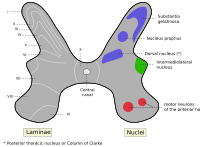
Photo from wikipedia
Introduction We use nerve conduct study (NCS) to evaluate the function of large fibers, skin sympathetic response (SSR) and contact heat evoked potential (CHEP) to evaluate the function of small… Click to show full abstract
Introduction We use nerve conduct study (NCS) to evaluate the function of large fibers, skin sympathetic response (SSR) and contact heat evoked potential (CHEP) to evaluate the function of small fibers in patients with impaired glucose regulation (IGR), The occurrence of peripheral neuropathy and damage characteristics are analyzed. Methods According to the classification criteria of glucose metabolism proposed by WHO 2006,we selected 120 patients with IGR, and 60 normal subjects as the control group.All subjects received median, ulnar, tibial, peroneal, sural nerve conduction study (NCS), skin sympathetic response (SSR) and contact heat evoked potential (CHEP) were performed using the Keypoint.net (Medoc Ltd) electromyogram device. Results 1.The abnormal rate of NCS in IGR patients were 22.5%; the abnormal rate of SSR was 39.2%, All patients with NCS abnormalities were associated with abnormal SSR 2.Compared with the control group, the tibial, sural nerve sensory nerve action potential (SNAP) amplitude decreased in IGR group, (2.01 ± 1.5) vs (1.51 ± 1.3) uV, t = −3.01, P = 0.003; (10.5 ± 2.0) vs (6.5 ± 1.9) uV, t = −2.82, P = 0.005 respectively; SSR amplitude reduced in upper and lower limbs (2124 ± 1346) vs (1463 ± 1140) uV, t = −3.21, P = 0.002; (892 ± 387) vs (531 ± 501) uV, t = −6.18, P = 0.00 respectively; CHEP amplitude decreased in dorsum hand and peroneal area stimuli respectively (63.0 ± 10.0) vs (52.4 ± 12.6) uV, t = 3.09, P = 0.003; (44.7 ± 12.5) vs (29.3 ± 12.1) uV, t = 5.84, P = 0.00.3.Compared with the control group, CHEP amplitude decreased in peroneal area stimuli in SSRN group [(44.7 ± 12.5) vs (33.1 ± 18.9) uV, t = 2.94, P = 0.00]; In NCSN group, CHEP amplitude decreased in dorsum hand and peroneal area stimuli compared with the control group respectively (44.7 ± 12.5) vs (28.4 ± 17.4) uV, t = 1.88, P = 0.00; (63.0 ± 10.8) vs (52.4 ± 15.3) uV, t = 2.22, P = 0.00. Conclusion The incidence of peripheral neuropathy (PN) in patients with IGR was 39.2%, Neuropathy showed large and small fiber damage, mainly manifested as small fiber and lower limb sensory nerve fiber damage,CHEP can find small fiber damage earlier than SSR and NCS in patients with IGR.
Journal Title: Clinical Neurophysiology
Year Published: 2018
Link to full text (if available)
Share on Social Media: Sign Up to like & get
recommendations!